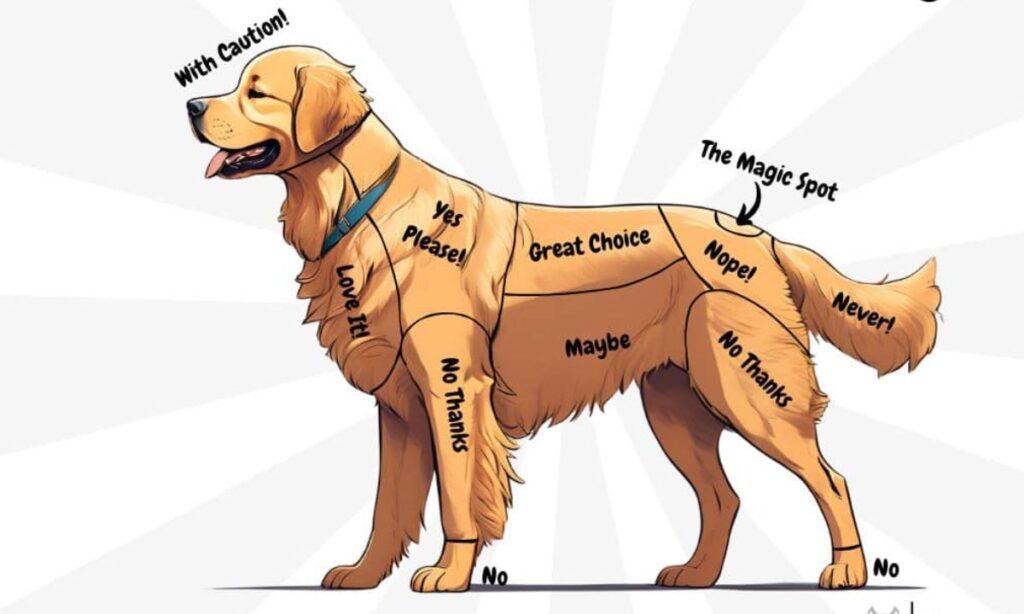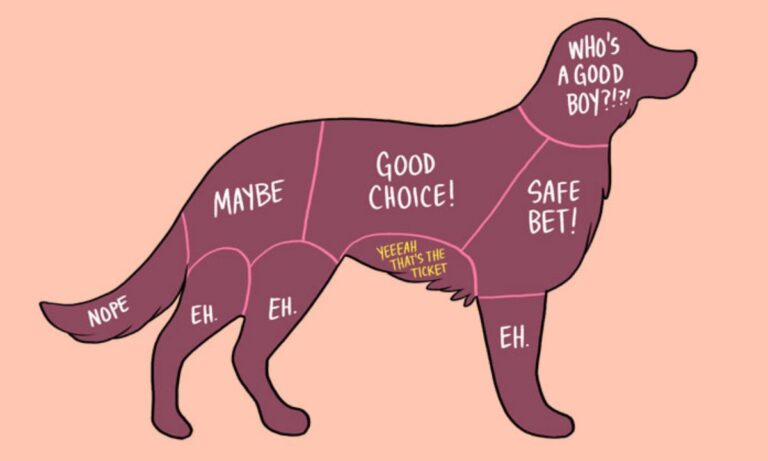Petting a dog is one of the simplest yet most rewarding ways to show affection to your furry friend. But it’s important to know how to pet a dog properly.
In this guide, we’ll dive into everything you need to know about how and where to pet a dog, signs your dog enjoys your touch, and the proper techniques for keeping your dog happy and comfortable.
Why Do Dogs Like to Be Pet?
Dogs have been domesticated for thousands of years, and they’ve learned to associate human touch with comfort, love, and safety. Petting can make a dog feel relaxed and secure. It releases endorphins, also known as “feel-good” hormones, which contribute to a sense of happiness.
Additionally, certain breeds are more likely to crave human interaction and physical touch. Petting can also be a source of relief for dogs who may be feeling stressed, anxious, or even physically uncomfortable.
How to Pet a Dog Properly
When you pet a dog, it’s important to consider both your approach and the technique you use. Here’s how you should go about it
Understanding why dogs like being petted can help you bond with them more effectively. Dogs may also enjoy the bonding that comes with being petted. It’s an act that strengthens their relationship with their owners.
Read This Blog; Difference Between CT Scan and PET Scan
Step-by-Step Guide to Petting
- Approach Calmly: Always approach a dog calmly and avoid sudden movements that could startle them.
- Let the Dog Come to You: Don’t rush to pet the dog. Let the dog come to you, as they will feel more comfortable if they initiate contact.
- Use Gentle, Steady Movements: When you start petting, use slow, gentle strokes. Dogs typically like a consistent rhythm.
- Pay Attention to the Dog’s Body Language: Watch for signs that the dog enjoys being petted, such as wagging their tail or leaning into your touch.
Key Tips
- Avoid petting too hard or too fast.
- Start at the head or neck and avoid the face or ears initially, as some dogs are sensitive in those areas.
- Be aware of the dog’s comfort level: If the dog pulls away or shows signs of discomfort, stop petting.
- By following these tips, you’ll ensure that your dog enjoys the experience and that you build a deeper, more trusting bond.
Should You Pet an Unfamiliar Dog?
When encountering an unfamiliar dog, it’s important to approach with caution. Not all dogs are open to being petted, especially if they haven’t been socialized well or are feeling anxious.
How to Approach an Unfamiliar Dog
- Ask Permission: Always ask the dog’s owner if it’s okay to pet their dog. Even if the dog seems friendly, it’s important to get approval.
- Approach Slowly: Move calmly towards the dog and avoid direct eye contact, as this can be seen as a threat.
- Extend Your Hand: Let the dog sniff your hand before petting. This helps the dog become familiar with your scent.
- Pet Gently: If the dog shows signs of being comfortable, gently pet the dog in areas like the neck or back.
Red Flags to Watch Out For
If the dog shows signs of aggression or discomfort, such as growling, baring teeth, or backing away, it’s best to respect the dog’s space and refrain from petting.
Where to Pet a Dog

When you pet a dog, it’s important to know which areas are generally safe and enjoyable for them. While all dogs are unique, there are common areas where dogs generally like to be petted.
Ideal Areas to Pet a Dog
- The Back: Most dogs enjoy being petted along their back. It’s a safe and comfortable spot for a quick petting session.
- Behind the Ears: Many dogs love being scratched behind the ears. It’s a spot they can’t reach on their own, so they often enjoy the sensation.
- Under the Chin: Some dogs love a good chin scratch. This is especially true for breeds that tend to be more affectionate.
Areas Dogs May Enjoy
- Chest and Neck: This area is usually safe and comforting for most dogs, especially larger breeds.
- Back of the Legs: Dogs enjoy a gentle rub along the back of their legs, particularly around the thighs.
Areas to Avoid Petting
While most dogs love a gentle touch, there are certain areas where you should avoid petting, as it can make them feel uncomfortable or even threatened.
- Sensitive AreasThe Face and Eyes Dogs often dislike having their face or eyes touched. They may feel threatened if you reach for their face.
- The Tail: Some dogs are sensitive about their tail area. Avoid petting the tail unless you are sure the dog enjoys it.
- Paws: Many dogs dislike having their paws touched, as it’s a vulnerable part of their body. However, some dogs can be trained to tolerate paw handling.
Signs a Dog is Uncomfortable
If the dog starts pulling away, growling, or snapping, it’s a clear sign that the petting session should end immediately.
Read This Blog; How to Get Pet Hair Out of Your Carpet
Signs Your Dog Enjoys Your Touch
Knowing how to read your dog’s body language is key to understanding whether they are enjoying your petting. Here are some common signs that indicate your dog is comfortable and happy with your touch:
- Wagging Tail: A wagging tail is often a sign of enjoyment. However, be aware of the speed and position of the tail – a slow wag might indicate uncertainty, while a fast wag shows excitement.
- Relaxed Body: If your dog’s body is relaxed and they lean into your hand, this is a positive sign. Tensed muscles may indicate discomfort.
- Licking or Nuzzling: If your dog licks you or gently nuzzles you, it’s an affectionate response that shows they are happy.
- Mouth Relaxed: A relaxed mouth (not tense or closed) indicates that the dog is comfortable.
- If your dog makes these signals, it’s a sign that you’re doing a great job in petting them.
Do Some Breeds Enjoy Pets More Than Others?
Yes, some dog breeds are more likely to enjoy being petted than others. Generally, affectionate breeds like Labradors, Golden Retrievers, and Cavalier King
Charles Spaniels are more likely to enjoy physical touch. These breeds are naturally friendly and affectionate towards humans.
Breeds That Typically Enjoy Petting
- Labrador Retrievers
- Golden Retrievers
- Beagles
- Pugs
- Cocker Spaniels
When Should You Stop Petting Your Dog?

It’s important to know when to stop petting a dog to avoid overstimulation or discomfort. If your dog starts showing any of the following signs, it’s time to stop:
- Tensing Up: If your dog’s body becomes stiff, stop petting immediately.
- Backing Away: A dog that backs away from your touch is telling you they’ve had enough.
- Growling or Snapping: These are clear signs that your dog is uncomfortable and needs space.
- Always respect your dog’s boundaries to maintain a healthy relationship.
Frequently Asked Questions
How can I tell if my dog enjoys petting?
Look for signs like a wagging tail, relaxed body posture, and leaning into your hand. If your dog is licking you or nuzzling you, it’s a positive sign.
Can all dogs be petted?
Not all dogs are comfortable with being petted, especially if they haven’t been properly socialized or have had negative experiences with humans.
Is it okay to pet a dog on the face?
Most dogs don’t enjoy having their face touched. It’s safer to pet them on their back or behind the ears.
How do I know if I’m petting too hard?
If the dog pulls away, growls, or seems tense, you may be petting too hard. Always use gentle, slow strokes.
Conclusion
Petting your dog is a simple yet powerful way to show your love and affection. By understanding where and how to pet a dog, as well as recognizing signs of enjoyment, you can create a more.
Bonded and trusting relationship with your furry companion. Always respect their boundaries and approach them calmly to ensure the experience is positive for both of you,
